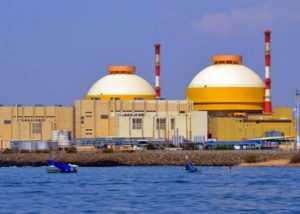Companion@360 → 7 Month programme to sharpen your writing skills → REGISTER NOW

Kudankulam Nuclear Power Plant
India and Russia have stepped up their cyber security cooperation in the backdrop of cyber-attack on Kudankulam nuclear power plant built by global nuclear major Rosatom. Indian authorities have appraised Russia that necessary steps have been taken to prevent similar incidents in future on the Indo-Russian joint venture.
History of Koodankulam Nuclear Power Plant:
-
- In 1988, during Rajiv Gandhi period a MOU (Memorandum of Understanding) for construction of nuclear power plant in India was signed between two countries India and Soviet (Russia).
- But due to several factors from political and economic crisis the project has been put on hold since there was a breakup in soviet and moreover with the objection from US stating that the agreement signed didn’t meet up with the current Terms and Conditions from the group of nuclear suppliers.
- Previously before 2004 the water reactor equipment was brought through roads as their mode of transport from Tuticorin port and due to various difficulties of damages incurred during its transportation.
- It decided to select a Naval point base and come up with an idea to develop a small port near the tip of the country and they felt the best place would be Koodankulam in southern part of Tamil Nadu and then a small port become operational on January 14, 2004.
- The main purpose of its construction is toreceive baggage’s carrying oversized light water reactor from ships anchored at a few distance of half a km from its port.
- In 2007 a MOU was signed between India and Russia and when Russian president Vladimir Putin visited India he had discussion with Manmohan Singh and both countries have planned to promote the use of nuclear energy to certain heights.
Practice Prelims Mock Test
Need for Koodankulam Nuclear Power Project:
- The KNPP reactors are being set up without sharing the Environmental Impact Assessment (EIA), Site Evaluation Study and Safety Analysis Report with the people, or the people’s representatives or the press.
- No public hearing has been conducted for the first two reactors either. There is absolutely no democratic decision-making in or public approval for this project
- The important issue of liability for the Russian plants has not been settled yet. Defying the Indian nuclear liability law, Russia insists that the InterGovernmental Agreement (IGA), secretly signed in 2008 by the Indian and Russian governments, precedes the liability law and that Article 13 of the IGA clearly establishes that NPCIL is solely responsible for all claims of damages.
- The quality of construction and the pipe work and the overall integrity of the KNPP structures have been called into question by the very workers and contractors who work there in Koodankulam. There have been international concerns about the design, structure and workings of the untested Russian-made VVER-1000 reactors.
- Even when the KNPP projects function normally without any incidents and accidents, they would be emitting Iodine 131, 132, 133, Cesium 134, 136, 137 isotopes, strontium, tritium, tellurium and other such radioactive particles into our air, land, crops, cattle, sea, seafood and ground water.
- Already the southern coastal belt is sinking with very high incidence of cancer, mental retardation, down syndrome, defective births due to private and government sea-sand mining for rare minerals including thorium. The KNPP will add many more woes to our already suffering people.
- The coolant water and low-grade waste from the KNPP are going to be dumped in to the sea which will have a severe impact on fish production and catch.
- This will undermine the fishing industry, push the fisher folk into deeper poverty and misery and affect the food security of the entire southern Tamil Nadu and southern Kerala.
- More than 1 million people live within the 30 km radius of the KNPP which far exceeds the AERB (Atomic Energy Regulatory Board) stipulations.
- It is quite impossible to evacuate this many people quickly and efficiently in case of a nuclear disaster at Koodankulam.
Facts and reasons for shutdown of Koodankulam Nuclear power plant:
- No proper canvassing has been given with the public in and around Nuclear power plant about the issues and construction of power plant.
- The opinion suggested regarding the plant by the Russian Scientist was made hidden and no Site Evaluation Study has been given to the public.
- According to Tamil Nadu Government act 828 – There should be no building other than power plant building till 2 km and 2 – 5 Km area should be a sterilization zone and the fact towards the people and their house location was hidden.
- According to AERB report within 5 Km there should not be population more than 20,000 and within 10 Km no area should be populated with 10,000 peoples but near to KNPP within 3 Km itself 20,000 people live in a village and 12,000 people from Idithankarai village and 450 families from Kasa village are being populated.
- Moreover within 10 Km there should be only less populated peoples but it doesn’t meet up with the criteria.
- Bad condition of the pipe, Local contractor, politicians, low priced goods are some reason of statement that comes in day today news from various Medias by taking this issue into consideration.
Malware attack:
- The NPCIL admitted that computer systems at the Kudankulam nuclear power station had been infected with malware since early September 2019.
- The NPCIL infection is said to be caused by Dtrack.
- Dtrack is a Trojan virus that creates backdoors into computer networks.
- This was originally developed and commonly used by North Korean hackers with state backing.
- However, there are many variations of Dtrack, and the code may have been adapted by another group.
Way Forward:
- Ramping up security across the power grid should be a strategic priority for the government.
- A holistic plan must be devised and implemented to prevent disastrous cyber attack



